Lavender is a spectacular plant, sung in songs, captivating with its marvelous aroma and delicate flowering. It will become a wonderful decoration for home landscape design and will be useful in everyday life. After all, from it you can prepare a healing, soothing decoction that relieves migraines, make a spice, perfume or cosmetic mask. By planting lavender on your site, you will turn it into a real fairy-tale place, where, in addition to fragrant smell And bright colors, butterflies and bees will circle. Such a spectacle can only be observed in the Alpine mountains or in French Provence. You won't have to spend a lot of effort to care for this plant, as lavender is unpretentious. The only thing she needs to provide is constant warmth, which she loves very much.
Lavandula, or Lavender, is an evergreen plant that blooms profusely. It grows as a low-growing spherical shrub (no more than 1 m in height and width), whose life expectancy is 10 years. Lavender flowers begin to bloom and bloom actively in June-July. In appearance they resemble spikelets, only not golden, but bright lilac color, as well as white, blue and pink. The leaves have an attractive silver-green color and give the plant a special decorative appearance. This luxurious fragrant plant is native to the Mediterranean region, so it is considered heat-loving and drought-resistant. However, not all existing lavender varieties can be successfully cultivated in open ground conditions in Russia. According to experienced gardeners, the best adapted to our climatic conditions is angustifolia lavender - Lavándula angustifólia, also known as true, English and spikelet lavender.

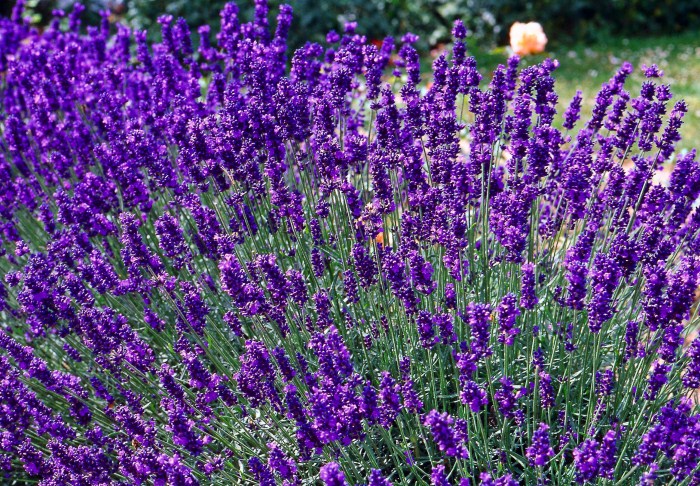

There is only one inflorescence on each stem of this lavender variety:
- Alba – blooms white;

- Rosea – has beautiful pink flowers;

- Hidcote – dark purple flowers;
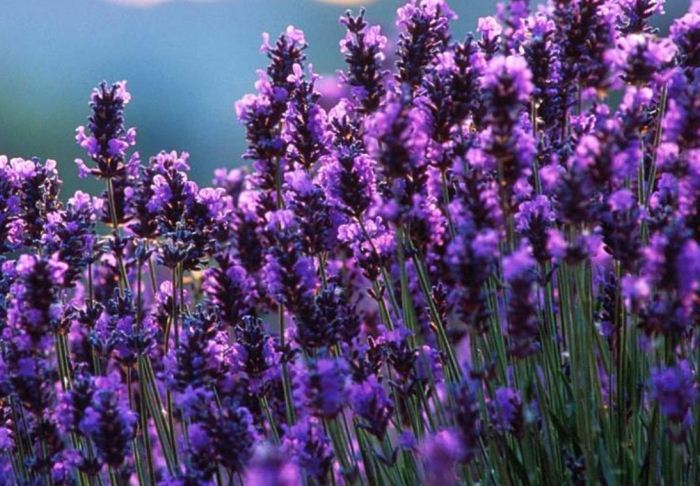
- Beechwood Blue - its flowers are lilac-blue;
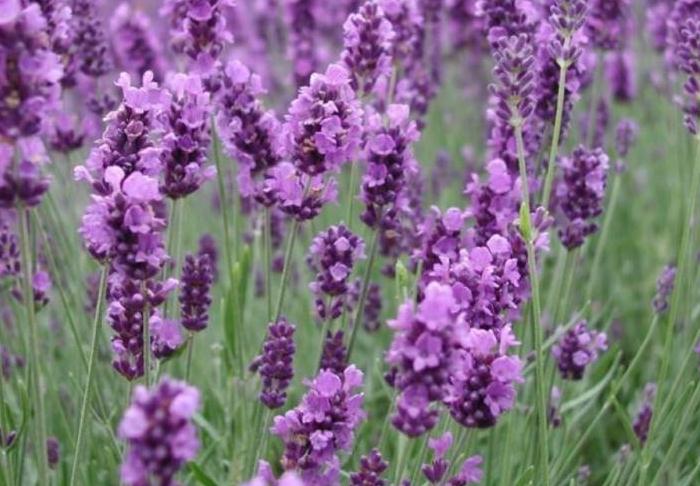
- Imperial Gem – has dark purple flowers;
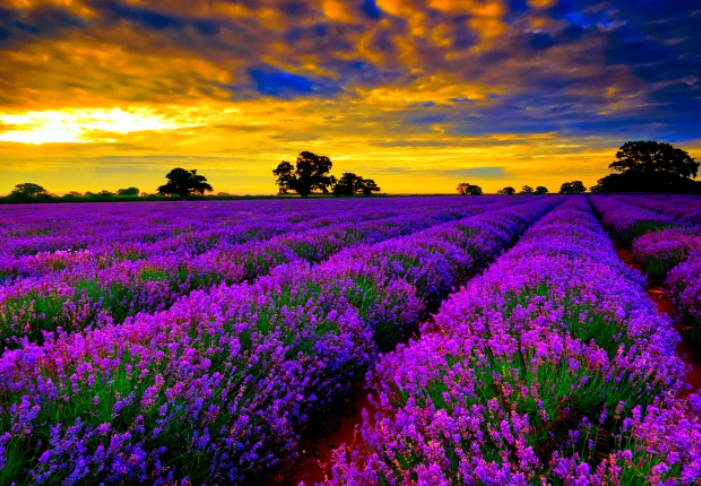
- Little Lottie – blooms pale pink;
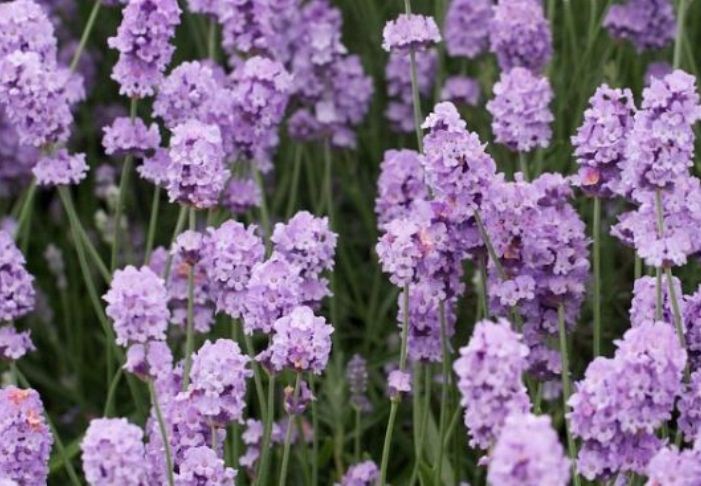
- Munstead - its flowers are lilac-blue;
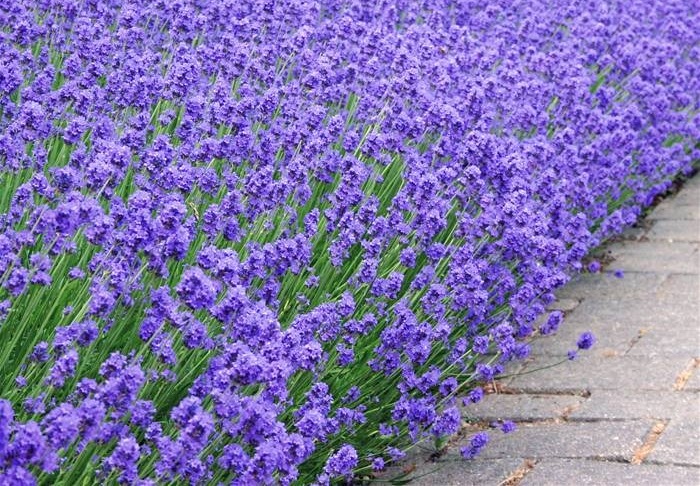
- Melissa Lilac - bears large purple inflorescences.
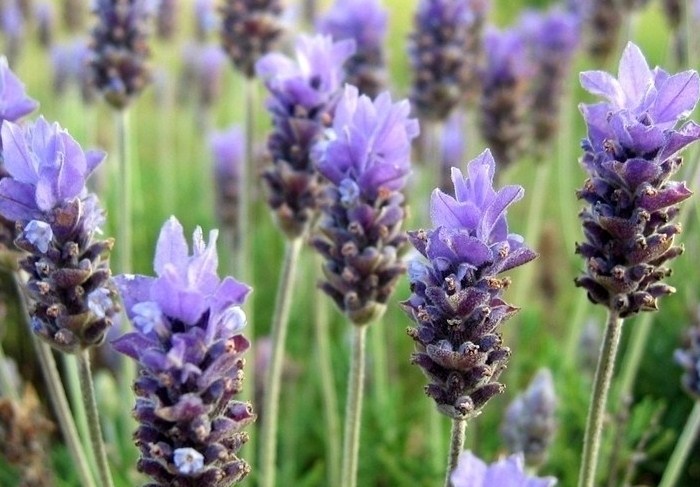
Varieties of lavender varieties
Lavender has more than 30 varieties and hybrids. Many of them grow only in wild natural conditions, and only a few species can be grown on your own garden plot. These include:
- Hybrid Dutch lavender, for which the most favorable conditions for growth they are stored in warm European countries. Growing long stems- up to two meters. I most often use it for industrial purposes.
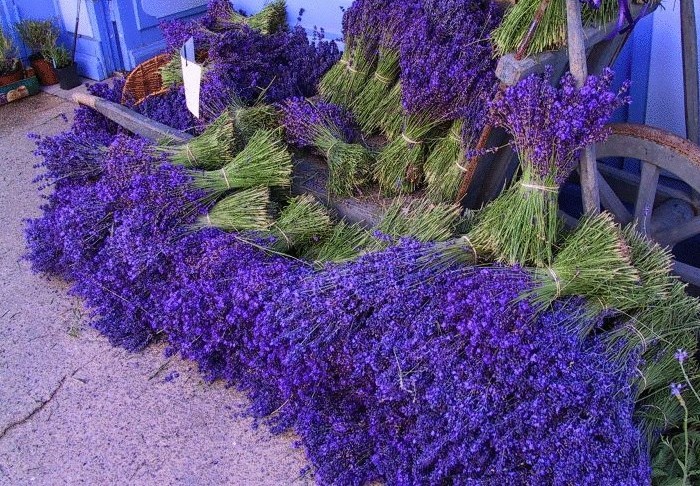
- broadleaf french lavender. Its peculiarity is that the aroma emanating from it is not always pleasant.
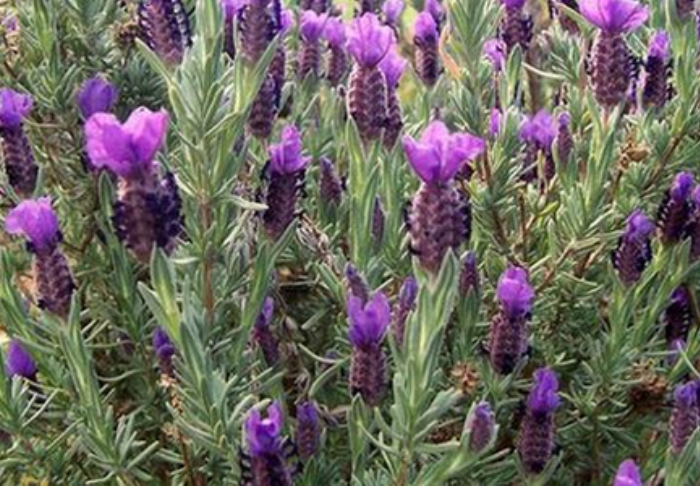
- Jagged Lavender – This can generally be grown in room conditions. It has a silvery tint and large flowers.
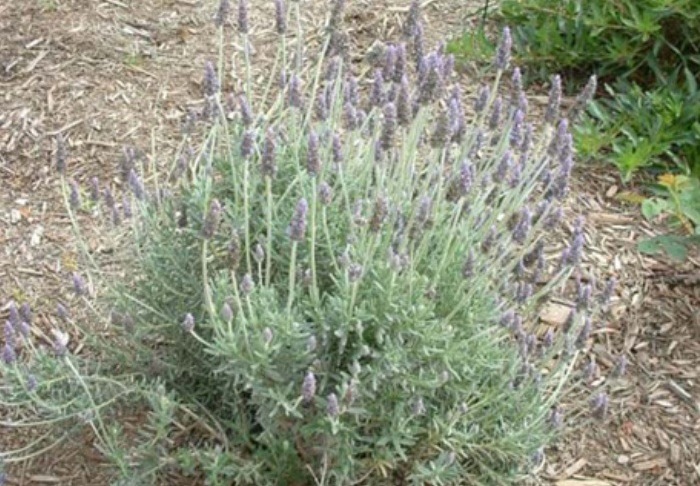
Beneficial properties of lavender and its uses
Lavender is a multifunctional representative of the green world. People have found wide application for it in many sectors of life.
- The plant itself has a very beautiful view, therefore it serves as an excellent decoration for a personal plot. In summer it will bloom and smell fragrant, and in winter, thanks to it, your yard will have picturesque landscapes - green bushes covered with snow flakes.
- Lavender flowers – excellent helpers in everyday life, they will protect our warm clothes from moths at any time of the year. To do this, you need to place the dried plant in a fabric bag and leave it in the closet with your things.
- Lavender can be used to make good spices that go well with meat dishes, soups.
- Lavender tea is an excellent soothing remedy that quickly relieves headache and migraine attacks.
- Dried lavender flowers can be used to decorate home interior in the form of ikebana.
- Lavender flowers can be used to make fragrant hair balm and hand cream.
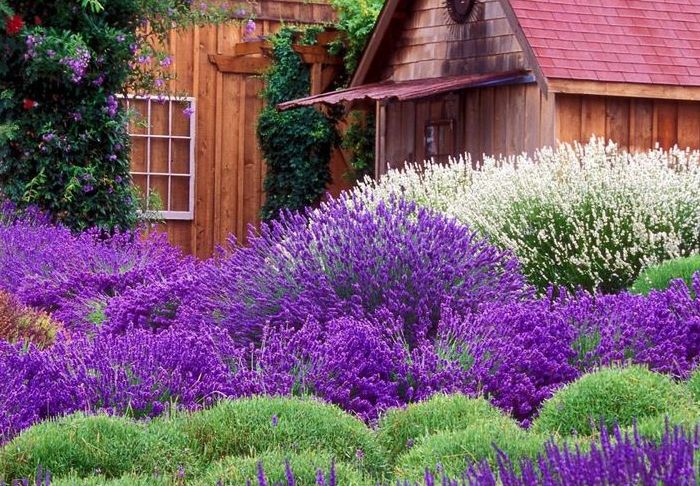
How to grow lavender at home
Lavender bushes can be propagated in several ways:
- Plant lavender seeds. This process is not easy and requires patience and time from the gardener. Therefore, this method of reproduction is used least often. But if you decide that you are ready to produce lavender seedlings yourself, then you need to follow a certain algorithm. First, collect the seeds. They usually appear in late September - early October. Then stratify the seeds - place them in the refrigerator and leave them there for a month and a half. Then plant the seedlings in boxes, which should remain indoors at room temperature.
- Plant lavender from cuttings. This method is considered the simplest. They are immediately planted in moist soil, covered with glass, you can also use oilcloth, and wait for the cuttings to germinate.
- Lavender is propagated by dividing the bush. They do this in the fall: they dig up the bushes and divide them into two parts, after which each is planted separately.
- This plant can be propagated by layering. To do this, you need to find 2-3 shoots, bend them into a small groove and let them take root there. On next year cuttings can be cut from the main bush.

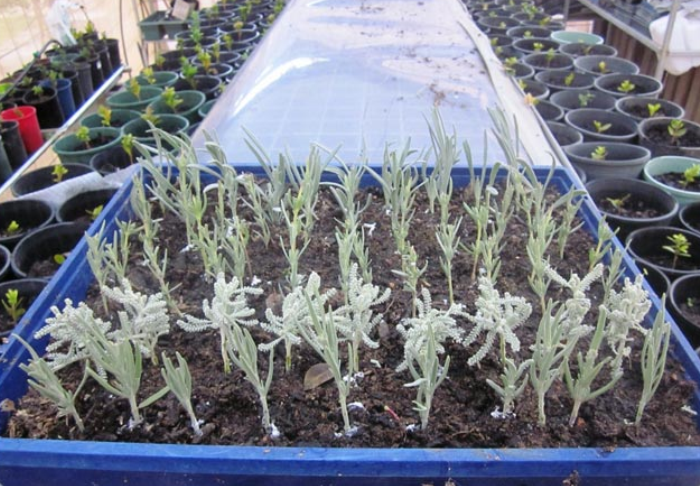
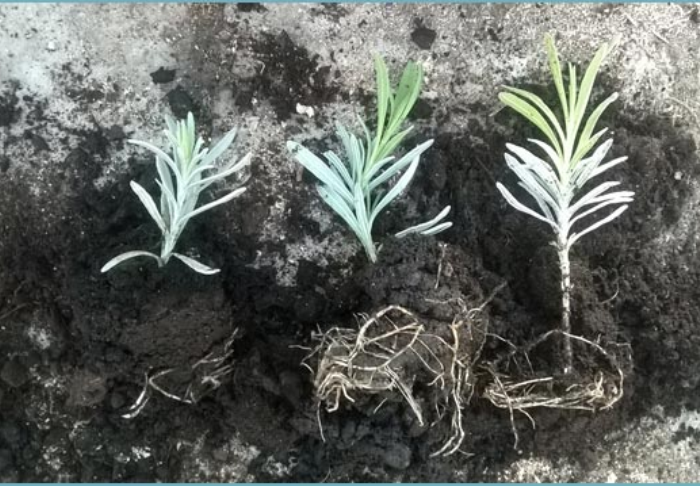

Features of planting lavender in open ground
Planting lavender bushes in open ground must be treated with great responsibility, since growing lavender requires compliance with certain rules:
- It's important to choose right place for planting lavender - it should be a spacious open land plot, which is well warmed up by solar heat. You can, of course, try to grow a shrub in the shade, but it is unlikely to please you lush flowering. The place you choose to plant lavender in the ground should not have groundwater or swamps lying high to the soil surface. If there is no other place in your homestead, be sure to fill the soil with drainage before planting lavender in open ground. On high humidity the plant may react poorly and die. Don’t forget to also fertilize the soil with ash or lime, which will perfectly saturate and loosen it.
- When planting shrubs, maintain a distance between them equal to their maximum height. If you want to make a decorative fence from lavender, then this distance can be halved.
- The holes for the bushes should correspond to the size of their rhizome with an earthen lump, while it is desirable that there is still a free space of 10-15 cm around the root.
- Before planting, the ends of the roots must be trimmed by 3 cm, and when filling them with soil, it is necessary to ensure that the neck of the root underground is 4-6 cm.
Methods for planting lavender in open ground
Gardeners recommend planting lavender mixed with roses and Santana. Firstly, such a flower bed will look great, and secondly, these flowers will grow better next to each other. But you can make separate flower beds from different types narrow-leaved lavender. There are several options on how to do this to give your yard an aesthetic appearance:
- Plant lavender bushes along sidewalks;
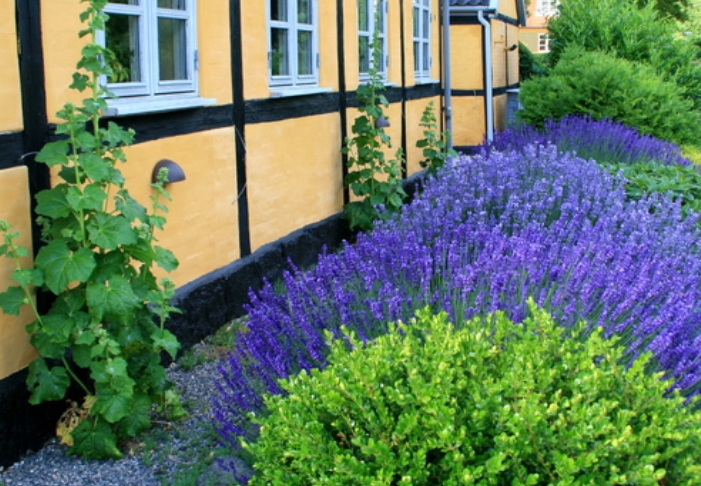
- In a checkerboard pattern - here you can combine different colors lavender;

- Create a “carpet” from this plant. But if you choose this planting option, you will need to constantly trim each bush. Outwardly it will look like lavender herb.

Features of lavender care
As we mentioned earlier, caring for lavender is very simple:
- It should be watered no more than once a week in the warm season, and twice a week in the cold season.
- In the fall, all bushes need to be trimmed. Leaving stems up to 5 cm long above the ground.
- In winter, lavender needs to be protected from frost with spruce branches or pine needles.
- You need to fertilize lavender either wood ash, or lime. At the same time, the plant can be mulched with humus. Nitrogen fertilizing should be excluded.
- If suddenly there is a need to replant a plant that lavender does not tolerate well, then it is better to do this during the dormant period - in the fall.

conclusions
Lavender is unique plant, to which no person can be indifferent. Having decorated your garden plot with it, you will never regret it and will enjoy the wondrous beauty of lavender bushes all year round, as well as use its gifts in everyday life.

Video “Lavender: planting and care”
In this video experienced gardener Irina Bagnyuk talks about how to properly plant lavender and care for it. At the same time, the expert clearly demonstrates this process.
Lavender refers to decorative garden plants, conquers with his blooming view and a subtle specific aroma.
Thanks to these wonderful qualities, it has won love and wide popularity among gardeners.
Many people rightly call lavender the queen of aromatherapy; its aromatic qualities have found their use in perfumery and the cosmetics industry.
In addition, it is practiced as a remedy for many diseases, and is also used in landscape design where the plant is worthy decoration any garden, plot or park. Lavender is also often used as a spice in cooking.
The plant is an evergreen bush with a large number of small flowers collected in a spike; it blooms in late summer. Flowers can be either purple, white, lilac or blue.
The shrub is quite unpretentious to soils, winter-hardy, prefers sunlight and moisture. The Mediterranean is considered to be its homeland.
Under natural conditions, lavender prefers mountainous areas with good humidity; it can be found in the maritime Alps, the Caucasus, Crimea, and also in the southern regions of Russia.
Role and use in landscape design
Lavender has a special place in landscape design, because the plant has an excellent aesthetic appearance and fits perfectly into the design of homestead areas, gardens, flower beds, parks, etc.
Its main advantage is its ease of planting and care, as well as its bright, rich color, which emphasizes the sophistication and individuality of any corner. Great option is the use of shrubs in creating flower and garden arrangements.
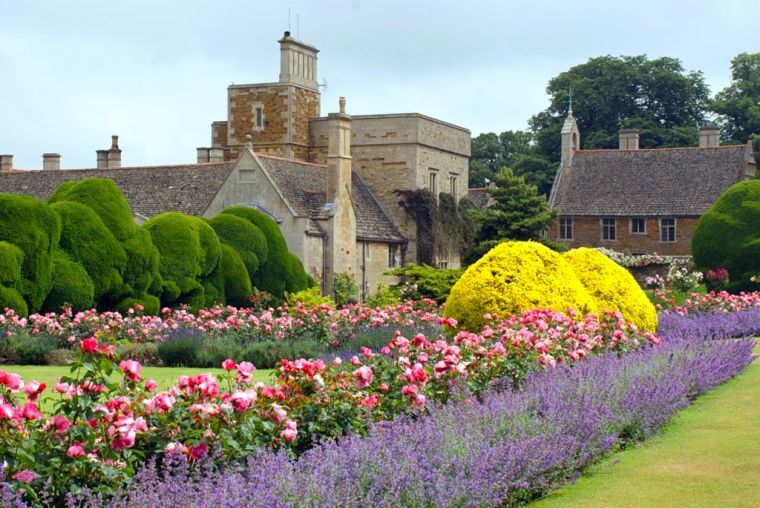
To decorate the edging of a garden alley, angustifolia lavender is very suitable, in summer period she will decorate the garden with her beautiful flowers, and in winter it will delight you with gray-green foliage.
A fragrant hedge is created from mountain lavender, as an option, several types of plants are used, this gives the fence an original and unusual look.
The shrub is also used as a background in many flower beds and gardens. An excellent “living carpet” is planted from low-growing varieties, which allows the plant to maximize its rich color shade.
In addition, lavender looks good both in single and group plantings.
Plant species diversity
There are more than 30 species in nature, all of them differ in size, shape, and color shades. The main types of lavender include:
- English. This is one of the most common frost-resistant species, which is widely known in England and far beyond its borders. Refers to perennial shrubs, height about 75 cm, has linear leaves of gray-green color and small lilac or blue flowers. Emits a delicate, refined aroma, contains a lot essential oils. Used in parks, gardens, and also as medicine and spices.
- Dutch lavender is the largest hybrid species, its height is more than 2 m. Refers to evergreen shrubs, has a spherical crown, narrow dark green silver leaves. The flowers, collected in inflorescences, are large and can be either white or dark purple or lilac. Due to its decorative effect, it is common in the design of gardens and parks.
- French lavender (broadleaf) mainly grows in France and some places Western Europe. It is distinguished by very beautiful bright flowers, purple, pink and lilac, which bloom much earlier than others. Flowering begins at the end of April and continues until the end of summer. This is mainly due to the high cold resistance of the shrub. Often this type planted in parks as a beautiful ornamental plant.
- Lavender woolly – unique variety whose homeland is Spain. Its leaves are covered with many dense hairs, and its flowers are collected in spike-shaped inflorescences. The plant is sun-loving, does not tolerate excess moisture and may die in heavy rainfall. It is very popular among gardeners and is perfect for decorating plots and gardens.

In the photo, woolly lavender
Choosing the optimal landing site
Of course, the key to successful growth of lavender is the correct location for planting in open ground.
The plant prefers open, ventilated areas with good lighting. It is not recommended to plant near water bodies and areas with high groundwater. They prefer elevation.
The soil for planting should be loose with a low level of acidity and moderate fertility.
Planting lavender with cuttings and seeds - what's the difference?
Lavender is planted in two main ways - cuttings and seeds:
- Planting with cuttings quite a simple method. It is as follows: you need to take several cuttings and root them in moist soil, deepening them by 5-7 cm, cover them and water them regularly. When the weather warms up, the cuttings are opened and they grow very quickly.
- Planting by seeds more complex method. First you need to stratify, then sow the seeds in a box with soil. For germination, planted seeds must be in a warm and well-lit place. Once they have germinated well, they can be planted in the ground. It is best to do this at the end of May. With this method, you should not wait for flowering in the first year, but in the subsequent year you will get developed plants with abundant flowers.
Plant care
The shrub is quite unpretentious, but still, lavender requires some care. Lavender should be watered as the soil dries out. overwatering may lead to root rot.

Photo of lavender pruning
It needs to be fed with potassium supplements, as it does not tolerate organic and nitrogen fertilizers. If the plant does not develop, then it requires a transplant, which is carried out in early spring or autumn.
For the formation of new shoots, regular mulching is necessary, which is carried out 2 times a year. In addition, the plant needs a little pruning, which is done at the end of the season.
In winter, it is advisable to cover the bushes with spruce branches or pine needles.
Fallen leaves are not suitable, as the lavender underneath may rot.
The video discusses planting and caring for lavender in open ground, and The right way plant trimmings.
Reproduction methods
Lavender can be propagated by seeds, cuttings, layering and dividing the bush.
Propagation by seeds is not an easy method, but by cuttings or layering it is much easier.
For that To propagate lavender by cuttings, young shoots are cut and planted in moist soil. To do this by layering, the branch is bent to the ground, secured and covered with humus.
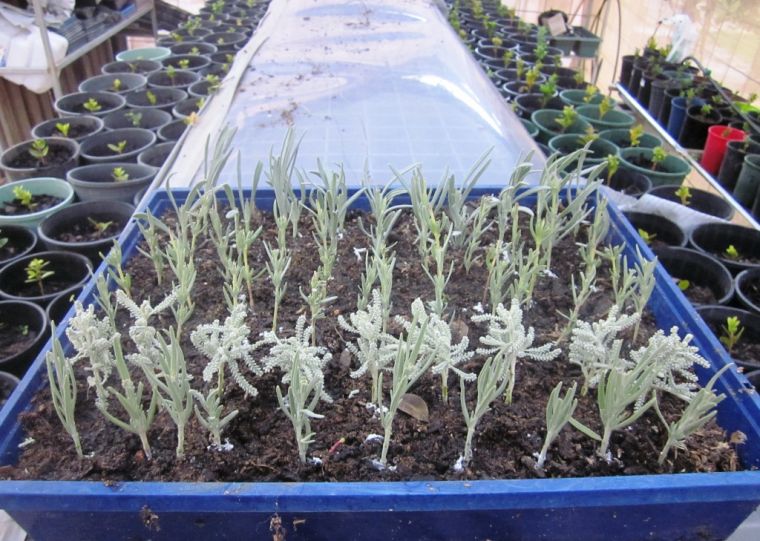
Propagation of lavender by cuttings
Over time, this branch gives roots. The division of the bush is carried out in the fall. Before this, it is cut to a height of 10 cm and covered with earth, filling the entire space between the stems; in the spring, soil is also added.
By autumn the bush has good and strong growth; it is dug up and divided.
Shrub Preferences
Lavender prefers to grow on mountain slopes and hills and loves light, sandy soil. To plant lavender in the garden, you should give preference to sunny areas; in a poorly lit place it may not bloom.
Capable of growing at severe frosts. It does not tolerate waterlogging well; heavy watering can lead to the formation of rot, but it tolerates drought easily.
Regular watering is necessary only in the first months of growth.
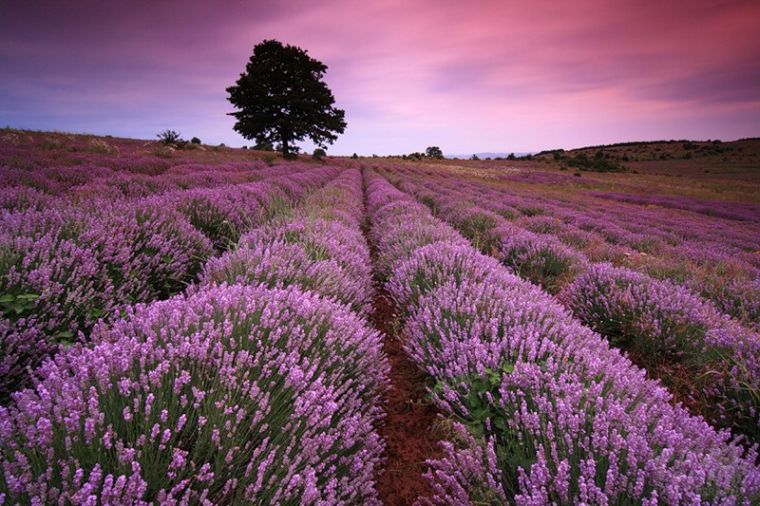
Lavender does not tolerate weeds that deplete the soil, which can eventually lead to the death of the plant.
Combinations with other plants
A special aroma and rich color cannot always be combined with all plants.
A good combination of lavender, sage and catnip, in the spring you can plant lilies of the valley and daffodils, and in the summer - sweet pea, mirabilis, etc.
An excellent option is roses and lavender; they combine with each other both in color and aroma. By color tone, this shrub, if it is purple in color, harmonizes well with yellow or orange flowers.

A wonderful composition of shrubs, as a background with purple coneflower or red dahlias.
Lavender is unique gift nature, which correct landing and proper care will be long time delight with its fragrant aroma and wonderful flowering. It will be a worthy decoration for any garden, park or suburban area.
The world of flora is surprisingly diverse and variable. It combines with amazing organicity the most different plants and many varieties of even the same crops. Lavender, which is represented by three dozen species, deserves special attention. In nature, this bright bush can be found in Australia, India, the Canary Islands, Arabia, southern Europe, North and East Africa. Easy landing Lavender and care make it very attractive to a huge number of gardeners.
French type of lavender
French lavender is no less common in the garden: planting and caring for this crop is not particularly difficult. However, it is worth considering that compared to the previous version, this variety is more finicky and capricious. Visually, the broad-leaved group is practically no different from the English variety. But often its inflorescences are somewhat shorter.
 Most often, it is French lavender that is grown on the balcony: planting and caring for this potted crop has certain characteristics, but in general there are no problems here. The plant is characterized by amazing beautiful flowers. The range of their shades is amazingly wide and includes such colors as:
Most often, it is French lavender that is grown on the balcony: planting and caring for this potted crop has certain characteristics, but in general there are no problems here. The plant is characterized by amazing beautiful flowers. The range of their shades is amazingly wide and includes such colors as:
- pink;
- lilac;
- green;
- burgundy;
- purple;
- white.
The attractiveness of this variety lies in the fact that it begins to bloom much earlier than its other “relatives”. Already in April and May, this lavender begins to smell fragrant. In the summer you can take the plant out into the garden.
Features of the narrow-leaved variety
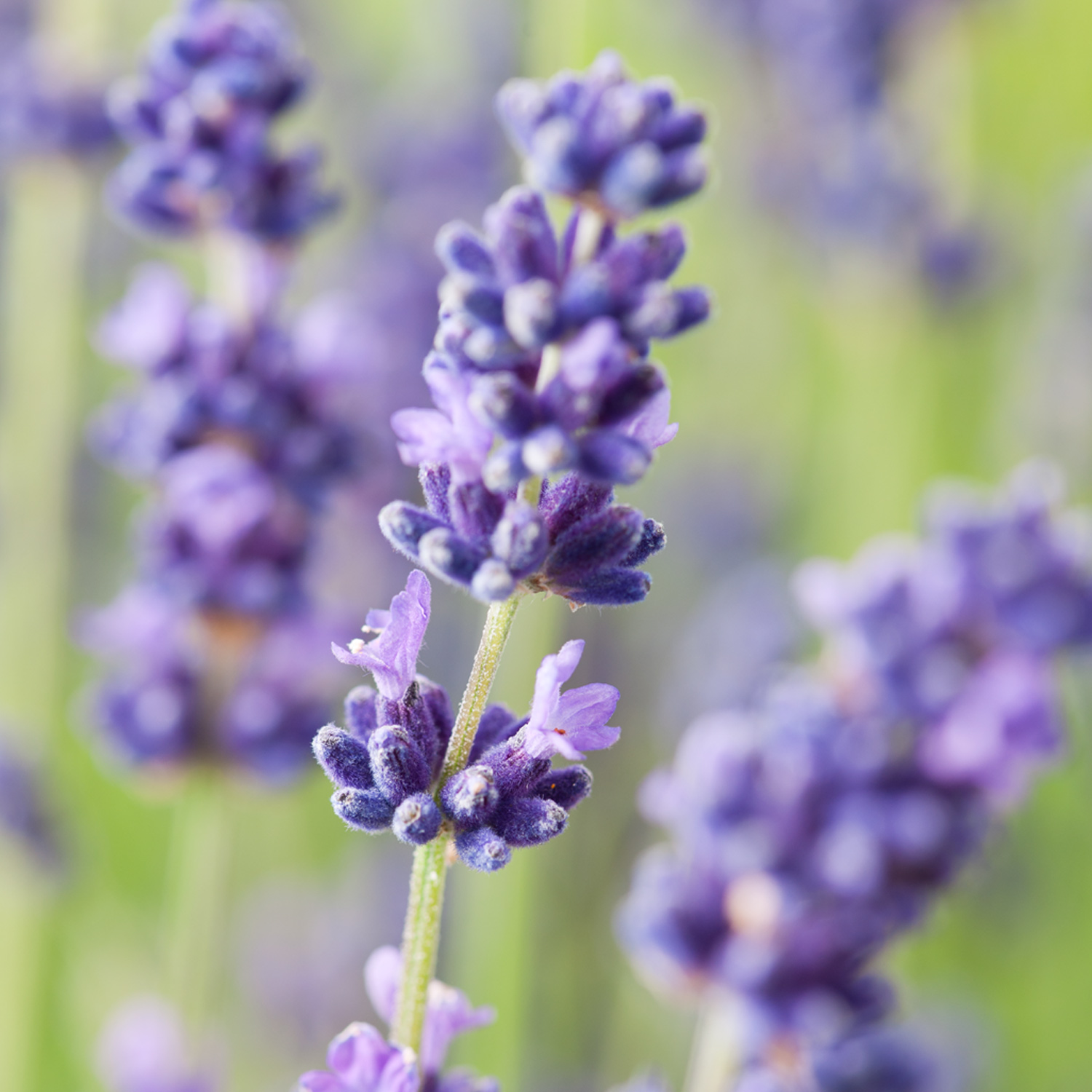 It is impossible not to make a reservation that there is lavender Angustifolia (Lavandulaangustifolia). This is a narrow-leaved variant, which is essentially a perennial evergreen subshrub. The flower is quite unpretentious. It is frost-resistant, which allows it to be actively grown in different regions. Moreover, this option can be cultivated in pots or tubs, which are removed indoors for the winter. For flower growers, this lavender is of particular value.
It is impossible not to make a reservation that there is lavender Angustifolia (Lavandulaangustifolia). This is a narrow-leaved variant, which is essentially a perennial evergreen subshrub. The flower is quite unpretentious. It is frost-resistant, which allows it to be actively grown in different regions. Moreover, this option can be cultivated in pots or tubs, which are removed indoors for the winter. For flower growers, this lavender is of particular value.
Among other features of this culture, it is worth noting the absence of a central stem. The bush is represented by a combination of several shoots. Sometimes their number reaches 400. Angustifolia lavender has a lot of features: planting and caring for this plant is also characterized by a number of nuances. Root system superficial flower. It is located very close to the top of the ground. It can be called highly branched, dense and quite rough. The leaf blades of this group of lavender are elongated and narrow. They are a rich green hue. The edges of the leaves are slightly bent.
Lavender Munstead
 Original Munstead Lavender is another representative of this group. This variety is considered narrow-leaved. This crop blooms in July and August. The perennial, formed in the form of a subshrub, is distinguished by the presence of fibrous and woody roots, numerous shoots, linear and opposite leaves. The shade of the plates is greenish-silver with gray tints. Plus they have a gentle and light pubescence. The height of the grass reaches 60 cm. This crop produces blue or bluish-lilac buds, collected in spike-shaped inflorescences.
Original Munstead Lavender is another representative of this group. This variety is considered narrow-leaved. This crop blooms in July and August. The perennial, formed in the form of a subshrub, is distinguished by the presence of fibrous and woody roots, numerous shoots, linear and opposite leaves. The shade of the plates is greenish-silver with gray tints. Plus they have a gentle and light pubescence. The height of the grass reaches 60 cm. This crop produces blue or bluish-lilac buds, collected in spike-shaped inflorescences.
Lavender Southern
This group also includes other varieties, for example, lavender angustifolia Yuzhanka, which requires creation certain conditions For successful cultivation. As for the description of the culture, this variety is different small height. Usually the perennial does not grow higher than 60 cm.
The attractiveness of the plant lies in the fact that it exudes a refined aroma.
Lavender Yuzhanka is very popular: planting and caring for this plant has a number of features. So, it is recommended to plant grass in sunny areas that are well protected from winds and drafts. The flower prefers light soils.  But the main requirement of Yuzhanka comes down to receiving a sufficient amount of ultraviolet radiation. In order for the variety to actively develop and bloom, the daylight hours must be at least 6 hours.
But the main requirement of Yuzhanka comes down to receiving a sufficient amount of ultraviolet radiation. In order for the variety to actively develop and bloom, the daylight hours must be at least 6 hours.
Southern lavender is not the only one included in the group of narrow-leaved varieties. Among other representatives of this species, it is worth noting the following varieties:
- Ellagance;
- Rosea;
- Munsted;
- Hidcote;
- Stepnaya;
- Alba;
- Record, etc.
Lavender Voznesenskaya 34
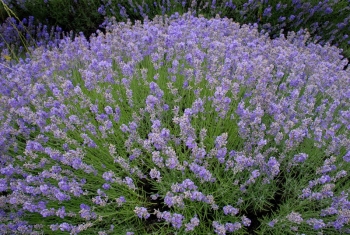 Among other plants of this species, lavender angustifolia Voznesenskaya 34 deserves attention, since it is widely used in folk medicine. The plant allows you to lift your spirits and relieve emotional overload. This fragrant perennial has honey-bearing and spicy-aromatic properties. The flower is medicinal, as evidenced by its antispasmodic and antiseptic properties. The variety, represented by a spherical bush with lilac-violet inflorescences, is used for medicinal baths, improving appetite, for neuralgia and bronchitis.
Among other plants of this species, lavender angustifolia Voznesenskaya 34 deserves attention, since it is widely used in folk medicine. The plant allows you to lift your spirits and relieve emotional overload. This fragrant perennial has honey-bearing and spicy-aromatic properties. The flower is medicinal, as evidenced by its antispasmodic and antiseptic properties. The variety, represented by a spherical bush with lilac-violet inflorescences, is used for medicinal baths, improving appetite, for neuralgia and bronchitis.
Variety of varieties and the most beautiful options
It is worth understanding the variability of this plant and its characteristics. different varieties. The Blue Space lavender deserves special attention, because it is not only attractive appearance, but also has healing properties. 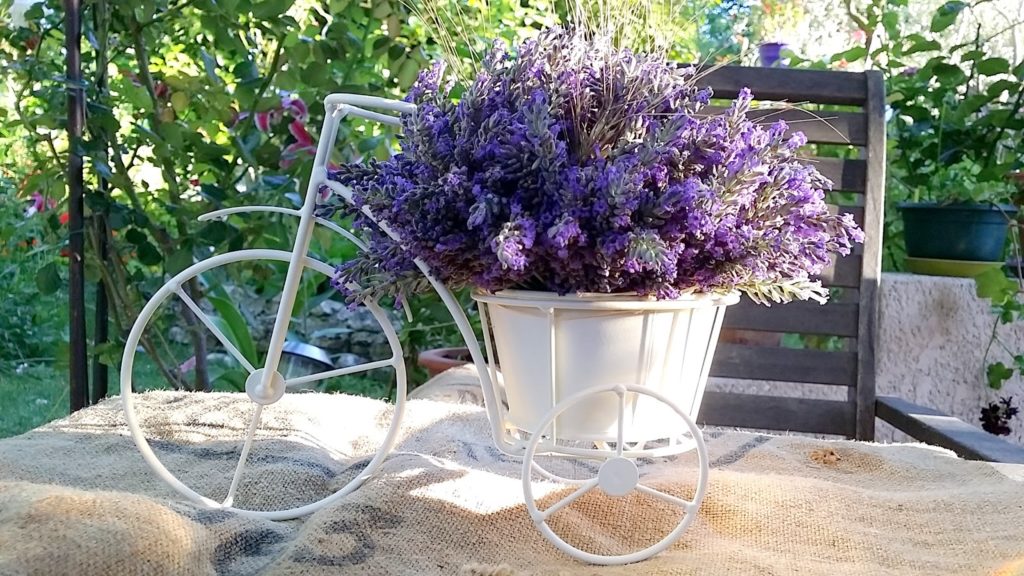 This herbaceous plant, related to perennials. The height of these flowers varies from 30 to 35 cm. Their stems are branched. The attractiveness of this type is that it is suitable for:
This herbaceous plant, related to perennials. The height of these flowers varies from 30 to 35 cm. Their stems are branched. The attractiveness of this type is that it is suitable for:
- cuttings for summer bouquets;
- designing winter flower arrangements;
- decorating areas.
Plus Blue Space is an excellent natural antiseptic. The herb is prescribed for neurasthenia and headaches. This type of lavender is grown from seeds: planting and caring for the flower are standard.
Lavender Butterfly and Victory
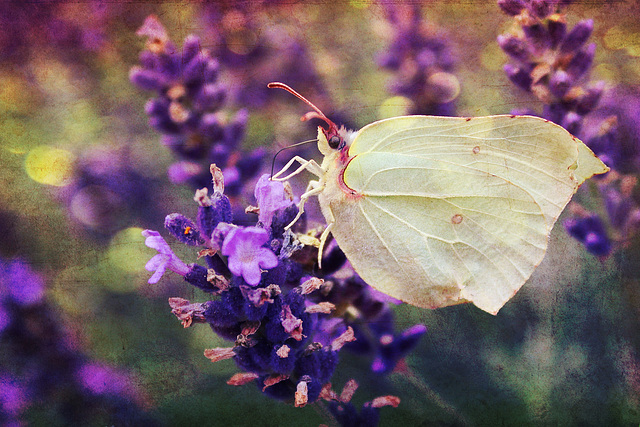 Another common solution is Butterfly lavender, which is known to gardeners for its original appearance. Fragrant flowers visually resemble butterflies. The height of this subshrub is 30 cm. This plant begins to bloom very early. Already in mid-April, buds are formed, which persist until July, and in the second half of summer a second flowering may begin.
Another common solution is Butterfly lavender, which is known to gardeners for its original appearance. Fragrant flowers visually resemble butterflies. The height of this subshrub is 30 cm. This plant begins to bloom very early. Already in mid-April, buds are formed, which persist until July, and in the second half of summer a second flowering may begin.
Another popular solution is Victory lavender, an essential oil perennial. It can grow up to 1 meter. The bush is quite spreading. Lanceolate-type leaf plates are formed on it. Their grayish tint goes well with unusual inflorescences in the purple spectrum. The attractiveness of this variety lies in its rich and fairly persistent aroma. Plus Victory is not afraid of frost and drought.
Lavender Delight
Uslada lavender deserves special attention, as it has some attractive features. It's fragrant and very beautiful plant evergreen type. The perennial grows up to 60 cm in height. This is a subshrub, which by its nature is a wonderful honey plant. The bush itself is compact and highly branched. The plant blooms in last days July.
 The flower feels best in sunny and fairly dry areas. Lavender is planted with seeds: growing and caring for this variety is based on the basic requirements of the culture. This type of lavender can be used as:
The flower feels best in sunny and fairly dry areas. Lavender is planted with seeds: growing and caring for this variety is based on the basic requirements of the culture. This type of lavender can be used as:
- soothing composition;
- seasoning;
- moth repellent;
- element of perfume composition;
- choleretic drug;
- remedy for neuralgia and rheumatic pain.
Lavender Mini Blue and Hidcote
 Another option is lavender Mini Blue with inflorescences of blue color. The height of the bush does not exceed 30 cm. The perennial subshrub is distinguished by the presence of linear and opposite leaves. This plant is grown in fresh and dry soil. The soil should be sandy-clayey, gravel and well permeable to moisture. It’s great if the substrate contains lime and nutrients in moderation. Grass grows and develops well in warm, sunny and even hot places. But this variety is quite sensitive to frost.
Another option is lavender Mini Blue with inflorescences of blue color. The height of the bush does not exceed 30 cm. The perennial subshrub is distinguished by the presence of linear and opposite leaves. This plant is grown in fresh and dry soil. The soil should be sandy-clayey, gravel and well permeable to moisture. It’s great if the substrate contains lime and nutrients in moderation. Grass grows and develops well in warm, sunny and even hot places. But this variety is quite sensitive to frost.
Another variety is Hidcote lavender: planting and caring for this narrow-leaved option is essentially no different from cultivating other similar herbs. Hidcote Blue performs compact variety. This perennial is grown as a framing element of plant compositions. It looks no less elegant and elegant along the paths. The attractiveness of this variety lies in its unique decorative properties. Even Hidcot's leaf blades have a greenish-silver tint. Bluish inflorescences form in mid-summer and dilute the rich aroma.
Some features of growing lavender
Any perennial lavender can be grown quite simply: planting and caring for it is not anything extremely complicated, the main thing is to plant the plant correctly.
This process is quite responsible. It is better not to move adult individuals from place to place, since they tolerate changing areas extremely poorly. If you have to do this, then you should replant the grass with a large earthen clod. It is recommended to leave quite a lot of space between neighboring plants, and the interval should be approximately equal. This will allow you to achieve a full and slender fit.
Planting lavender on the site
 Among other features of this process, it is worth noting the possibility of planting crops not only with seeds, but also with cuttings. Moreover, the second option is preferable, since in this case the flowers take root better. The algorithm for doing the job is extremely simple. The bushes only need to be deepened into loose soil a couple of centimeters. Then they are covered with film. They need to be watered systematically. Rooted specimens are transplanted to the required area.
Among other features of this process, it is worth noting the possibility of planting crops not only with seeds, but also with cuttings. Moreover, the second option is preferable, since in this case the flowers take root better. The algorithm for doing the job is extremely simple. The bushes only need to be deepened into loose soil a couple of centimeters. Then they are covered with film. They need to be watered systematically. Rooted specimens are transplanted to the required area.
Soil requirements
 Garden lavender is not difficult to cultivate: planting and caring for it involves watering, fertilizing, loosening, and weeding. The flower does not like dense soils, since the root system of the plant is demanding of high-quality air circulation. Weeding and loosening should be done regularly. You can also form a dense layer of mulch. To do this, use multi-colored decorative substrates or rotted foliage. The main thing is to leave the soil open near the base of the trunk to prevent rotting.
Garden lavender is not difficult to cultivate: planting and caring for it involves watering, fertilizing, loosening, and weeding. The flower does not like dense soils, since the root system of the plant is demanding of high-quality air circulation. Weeding and loosening should be done regularly. You can also form a dense layer of mulch. To do this, use multi-colored decorative substrates or rotted foliage. The main thing is to leave the soil open near the base of the trunk to prevent rotting.
Rules for watering lavender
Lavender is a flower, the mention of which brings to mind endless purple fields in French Provence. But now in Russia, many professional flower growers and decorators, as well as amateur gardeners, are engaged in growing lavender. It is used for decoration alpine slide, creating a shrub border or simply for decorating a flower bed.
In nature, lavender grows beautifully on mountain slopes, held in place by three-meter-long roots. She represents perennial evergreen shrub, the leaves of which have a silvery tint, and the flowers - from traditional lilac to unimaginable white.
Species diversity
To date There are more than 45 varieties of lavender known, but most often the following varieties are used when decorating a garden:
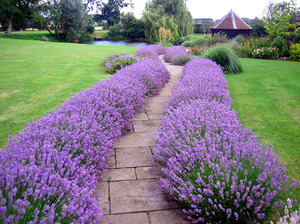
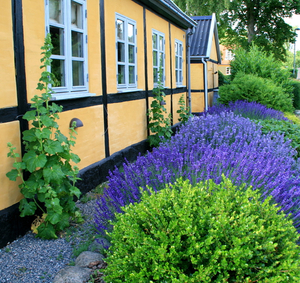 To successfully grow lavender in the garden, an indispensable condition is right choice places. That should be enough sunny plot. Partial shade is also suitable for planting, but in such conditions you should not expect long and abundant flowering.
To successfully grow lavender in the garden, an indispensable condition is right choice places. That should be enough sunny plot. Partial shade is also suitable for planting, but in such conditions you should not expect long and abundant flowering.
The flower is quite sensitive to humidity levels; it is not suitable for wet soil or a place where groundwater flow too high. Planting in the driest soil is considered preferable. If there is no choice, then experts recommend the installation of artificial drainage layers.
You should also pay attention to soil acidity level. Any type of lavender can only benefit from alkaline or neutral soil. To reduce acidity levels, you can add a small amount of lime or ash to the soil before planting. In addition, regular fertilization with compost will be useful to increase the nutritional value of the soil and improve its drainage qualities. But adding nitrogen or manure can have a detrimental effect on flowering.
Gardening experts often advise placing lavender on personal plot Near vegetable crops – sharp and strong aroma emanating from flowers can repel insect pests.
When planting a plant in the ground, it should be taken into account that the distance between individual bushes may not be greater than their maximum height. In case of registration decorative hedge this distance is halved.
Growing lavender from seeds
Most in a complicated way Experts consider growing lavender to be growing a bush from seeds.
Before planting seeds in the soil, they need to be hardened off. In warm European countries, where there are no severe frosts, stratification occurs naturally. To do this, selected seeds are planted directly in the ground at the end of autumn. More acceptable in our climate zone artificial stratification. Lavender seeds need to be mixed with sand, poured into a small container, wrapped plastic film and store in the refrigerator for about a month and a half.
Prepared lavender seeds are planted towards the end of spring in greenhouses along with sand under a not too thick layer of soil. And when the first shoots appear, they can be safely transplanted to previously prepared places.
One of the disadvantages of this method of growing is the long preparation of the plant itself for flowering: for the first year or two, the shrub will grow a root system, flowers will appear much later.
Growing lavender from cuttings
This is a fairly simple method and is used in practice very often. First you need to prepare cuttings from woody shoots of one or two years, which are then cut to a length of no more than 10 cm. planted in loose soil by 2–3 cm, cover with film and water regularly. The roots of the cuttings germinate very quickly, after which it can be transferred to open ground.
Growing lavender using stem layering
 This method of propagating lavender is considered the simplest. All that is required of the gardener is to lay one branch of the bush he likes horizontally, cover it completely with earth and put some weight on top. After about a few months, the cuttings will develop their own root system and can be cut off from the parent bush and planted independently. Cut location required sprinkle with crushed coal to avoid rotting of the main bush.
This method of propagating lavender is considered the simplest. All that is required of the gardener is to lay one branch of the bush he likes horizontally, cover it completely with earth and put some weight on top. After about a few months, the cuttings will develop their own root system and can be cut off from the parent bush and planted independently. Cut location required sprinkle with crushed coal to avoid rotting of the main bush.
Growing lavender from shoots
Another breeding method that can be easily used in practice. In the fall, the selected bush is cut to 10 cm and sprinkled with soil, then with the onset of spring you need to trim it again. Next fall there will be enough shoots to divide the bush into several new ones.
Lavender is a genus of herbs belonging to the Lamiaceae family; it has approximately 20 species of plants. Narrow-leaved lavender - bright representative of this genus, an evergreen perennial. It is most resistant to cold, which is why it is widespread in Russia. On this “Popular About Health” page, readers will become more familiar with planting lavender and caring for it in the ground. What are the features of this culture? What are her preferences?
Lavender angustifolia – photo, brief information about culture
Externally, angustifolia lavender is a lush bush that does not have a stem. It consists of numerous shoots, the number of which can reach up to four hundred! The plant can grow to a height of up to 1 meter, but there are also low-growing specimens up to 35 cm. The root system of the plant is located superficially, the roots are highly branched. The shoots are covered with soft pile, which gives the plant a bluish tint.
The leaf blades are narrow, pointed, green. Inflorescences are spicate with small flowers lilac shade. The flowering period is quite long and occurs from June to mid-August. When lavender blooms, this sight cannot but delight - the entire surface of the bushes acquires a lilac-lilac color, and all this beauty is accompanied by pleasant aroma. It is not for nothing that lavender is used in the perfume industry. How to grow it?
Choosing a landing site
Lavender is a native of southern latitudes; it loves warmth and does not tolerate wind. Therefore, it is worth thinking about where the plant will be more comfortable. Find a place protected from the wind, but located in the sun. Lavender in open ground can be destroyed by groundwater that lies shallow underground. That is why the crop is usually planted at higher elevations. If your site has predominantly heavy, acidic loams, the plant will not survive. Ideal composition soil for angustifolia lavender - the components taken in equal parts are sand, humus and leaf soil. The acidic soil is limed before planting, and the area itself is dug well, mineral fertilizers are applied and loosened.
Planting in open ground
Lavender seedlings are sold in gardening stores. Buying it in the spring is not a problem. How to plant it on the site? First, decide on the planting scheme. Your further actions will depend on this. If you want to end up with a solid lavender carpet, then you need to dig a trench about 25 cm deep, and place the seedlings themselves at a distance of about 30-40 cm (do not forget that the bushes will become more voluminous as they develop). Lime the soil from the pit, add the necessary components for looseness and lightness - sand, humus, peat. Plant the seedlings in drops, lightly compact the soil, and water moderately.
Sowing lavender: planting seeds
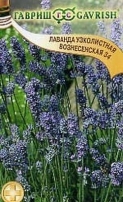 In cold regions, this method is not used very often, but it has a right to exist. Lavender angustifolia seeds need stratification. Therefore, they are placed in a mixture of peat and sand, placed in a bag and placed in the refrigerator for 5-6 weeks. Then the seeds are germinated at a temperature of about 16-18 degrees in a mini-greenhouse, while maintaining low soil moisture. When sprouts appear and several pairs of leaves form on them, the seedlings dive. Seedlings can be planted in the ground no earlier than the end of May, and in cold regions - in June.
In cold regions, this method is not used very often, but it has a right to exist. Lavender angustifolia seeds need stratification. Therefore, they are placed in a mixture of peat and sand, placed in a bag and placed in the refrigerator for 5-6 weeks. Then the seeds are germinated at a temperature of about 16-18 degrees in a mini-greenhouse, while maintaining low soil moisture. When sprouts appear and several pairs of leaves form on them, the seedlings dive. Seedlings can be planted in the ground no earlier than the end of May, and in cold regions - in June.
Caring for angustifolia lavender
The plant requires moderate watering when the soil is completely dry - an abundance of moisture leads to rotting of the roots. Weeding is necessary. It is better to mulch the ground around the plants right away to reduce the time and effort spent on weeding and loosening. Nitrogen fertilizing is needed only at the beginning of growth, to gain green mass of the plant. During flowering, lavender needs mineral fertilizers. The bushes need to be pruned after flowering, but not too much. Just cut off the faded tops of the inflorescences and shape the bush. When growing in the ground, plant care should include preparation for wintering. Lavender should be well covered with a thick layer of spruce needles or oak leaves. Polyethylene cannot be used, otherwise the plants will rot. Among crop diseases, the most common is gray rot, which develops due to waterlogging.
An easy way to propagate lavender angustifolia
The most commonly used method of propagating lavender is cuttings. Shoots from an adult bush take root easily in the soil at a temperature of about 20 degrees. Shoots are best suited for this procedure. current year, young shoots. Cut off a few branches that have at least 2 nodes (the seals on the stems from which leaves later emerge). Cut the shoots into cuttings 12-13 cm long (each fragment should have a couple of growth nodes). Root them in a mixture of peat moss and perlite. After 5-6 weeks, the cuttings will have their own roots. In the future, they can be planted directly into the ground. But keep in mind that after planting young lavender, some time must pass before the onset of cold weather (at least a month) for the plants to get stronger and take root, then they will not die in the winter.
Lavender angustifolia is a wonderful representative of the earth's flora. She is able to decorate any garden, making it a real heavenly place that brings pleasure. Try growing it in your own garden to enjoy its wonderful aroma in the evenings.
